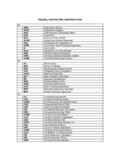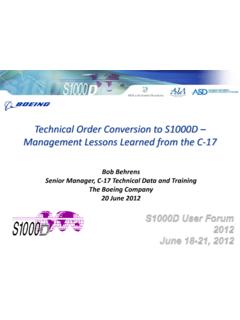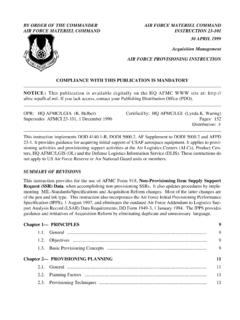Transcription of Temperature-controlled transport operations - WHO
1 ` WHO Vaccine Temperature-controlled transport operations Technical supplement to WHO Technical Report Series, No. 961, 2011 Annex 9: Model guidance for the storage and transport of time and temperature sensitive pharmaceutical products January 2014 World Health Organization 2014 WHO Press, World Health Organization, 20 Avenue Appia, 1211 Geneva 27, Switzerland (tel.: +41 22 791 3264; fax: +41 22 791 4857; e-mail: Requests for permission to reproduce or translate WHO publications whether for sale or for noncommercial distribution should be addressed to WHO Press, at the above address (fax: +41 22 791 4806; e-mail: The designations employed and the presentation of the material in this publication do not imply the expression of any opinion whatsoever on the part of the World Health Organization concerning the legal status of any country, territory, city or area or of its authorities, or concerning the delimitation of its frontiers or boundaries.))
2 Dotted lines on maps represent approximate border lines for which there may not yet be full agreement. The mention of specific companies or of certain manufacturers products does not imply that they are endorsed or recommended by the World Health Organization in preference to others of a similar nature that are not mentioned. Errors and omissions excepted, the names of proprietary products are distinguished by initial capital letters. All reasonable precautions have been taken by the World Health Organization to verify the information contained in this publication. However, the published material is being distributed without warranty of any kind, either expressed or implied. The responsibility for the interpretation and use of the material lies with the reader. In no event shall the World Health Organization be liable for damages arising from its use. The named authors alone are responsible for the views expressed in this publication. Technical Supplement: Temperature-controlled transport operations 1 Acknowledgments The author of this document is Kevin O Donnell, Exelsius Cold Chain Management Consultancy and member of the United States Pharmacopeia Expert Committee of Packaging, Storage and Distribution 2010-2015 cycle.
3 Contributions to the document have also been made by Jim Bacon, Senior Director, Demand Planning and International Customer operations - US Office, Grifols, Inc. Technical Supplement: Temperature-controlled transport operations 2 Contents Acknowledgments .. 1 Contents .. 2 Abbreviations .. 3 Glossary .. 4 1. Introduction .. 8 Requirements .. 8 8 Target readership .. 8 2. Guidance .. 10 Associated materials and equipment .. 10 Available shipping systems .. 10 Refrigerated vehicles .. 10 Temperature-controlled vehicles .. 10 Passive shipping 11 Active shipping systems for air transport .. 12 Active shipping systems for ocean transport .. 12 Defining user requirements .. 13 User Requirements Specification .. 13 Service Level Agreements (SLAs) .. 13 Identifying and controlling risk .. 14 Managing refrigerated road 17 Managing passive container road shipments .. 18 Introduction to air transport .. 19 Types of air carrier.
4 20 Air transport labelling .. 21 Air transport 22 Managing air shipments .. 22 References .. 26 Annex 1 Packing a refrigerated vehicle .. 27 Revision history .. 28 Technical Supplement: Temperature-controlled transport operations 3 Abbreviations AWB Air Way Bill CI Chemical Indicator CRT controlled Room Temperature ETI Electronic Temperature Integrator EDLM Electronic Data Logging Monitor IATA International Air transport Association NOTOC Notice to Captain PDA Parenteral Drug Association SLA Service Level Agreement SOP Standard Operating Procedure TTI Time-Temperature Integrator TTSPP Time- and Temperature-Sensitive Pharmaceutical Product ULD Unit Load Device URS User Requirements Specification Technical Supplement: Temperature-controlled transport operations 4 Glossary 3PL: Third party logistics provider: a firm that provides service to its customers of outsourced (or "third party") logistics services for part, or all of their supply chain management functions.
5 4PL: Fourth party logistics provider: a general contractor who manages other 3 PLs, truckers, forwarders, custom house agents, and others, essentially taking responsibility for a complete logistics process for the customer. Active systems: Externally powered or on-board powered systems using electricity or other fuel source to maintain a Temperature-controlled environment inside an insulated enclosure under thermostatic regulation ( cold rooms, refrigerators, Temperature-controlled trucks, refrigerated ocean and air containers). Advanced Phase Change Materials (PCMs): Temperature stabilizing media (sometimes referred to as refrigerants), chemically engineered so that their latent heat of fusion occurs at a temperature other than zero C, phasing from one state of matter to another ( liquid to solid) at a pre-formulated temperature. Such materials are typically comprised of oils, salts, or paraffin. Ancillary packaging components: Packaging elements used to protect the TTSPP and support or enhance performance of the completed package.
6 This may include retainers, dunnage, secondary protective packaging, and temperature data logging devices. Chemical indicators: (also called markers or phase-change indicators), are generally impregnated onto a paperboard substrate. These indicators, sometimes referred to as critical temperature indicators, are based on a phase change or chemical reaction that occurs as a function of temperature. Examples include liquid crystals, waxes, polymers, and lacquers that change phase, and thereby their appearance, as a function of temperature. Chemical temperature threshold indicators may be reversible or irreversible and are suitable for high or low temperatures . Temperature threshold indicators show a response and typically are single-use devices. These indicators provide a signal only when exposed to temperatures higher than (ascending indicator) or lower than (descending indicator) a predetermined threshold temperature. They typically use liquid diffusion technology to signal when a single event time-temperature threshold has been exceeded by irreversibly changing colour, either instantaneously or with some time delay.
7 The active colloidal substance in freeze indicators is typically composed of particles of material evenly distributed within a liquid. At a specific relative temperature the particles in the marker colloid become unstable, eliminating the repulsive forces that keep the particles separate. The chemicals coagulate, resulting in a change of colour. The accuracy and precision of these indicators depend to some extent on human interpretation. Electronic temperature monitoring and event logger system: A system for recording and reporting air and/or product temperatures , with optional facilities for recording and reporting specific events such as door-opening or defrost cycles and for issuing alarms. Such systems may be user-programmable may also be remotely monitored via a satellite link. Technical Supplement: Temperature-controlled transport operations 5 Electronic Data Integrator (EDI): A hybrid electronic instrument intelligently programmed like an Electronic Temperature Indicator (ETI) with the report/data producing capabilities of an Electronic Data Logging Monitor (EDLM) that combines the features and functions of a Go/No-Go device (like and indicator) with the record retention and data tracking of an EDLM but with greater granularity and data management flexibility.
8 It uses pre-programmed temperature threshold intelligence to integrate post-analytic functional steps that are typically performed by trained personnel. Electronic Temperature Indicator (ETI): A compact, portable device that measures, temperature over time by means of a built-in sensor. They come in a wide range of forms, features, configurations, cost and levels of performance. Their composition consists of four basic components: a thermistor sensor, a microprocessor, a memory chip, and power source (lithium battery). They provide either a single temperature threshold or multiple alarm thresholds. These devices are employed for simple accept / reject decision making, and their time and temperature accuracy is quite precise. Electronic Data Logging Monitor (EDLM): A small portable device that measures and stores temperature at a pre-determined time intervals by means of an electronic sensor. They have programmable alarm capabilities, integrated displays, and can create reports and graphs which may be permanently stored, shared and analysed via proprietary hardware, software, desktop application or through hosted databases.
9 External distribution: transport of TTSPPs through various steps in the customer s supply chain ( transport from a pharmaceutical manufacturer s distribution centre, to commercial customers (including wholesalers, retailers and buying groups), to clinical facilities or direct to the patient). Passive systems: Systems which maintain a Temperature-controlled environment inside an insulated enclosure, with or without thermostatic regulation, using a finite amount of pre-conditioned coolant in the form of chilled or frozen gel packs, phase change materials, dry ice or others. Pharmaceutical product: Any product intended for human use or veterinary product intended for administration to food producing animals, presented in its finished dosage form, that is subject to control by pharmaceutical legislation in either the exporting or the importing state and includes products for which a prescription is required, products which may be sold to patients without a prescription, biologicals and vaccines.
10 It does not, however, include medical devices1. Refrigeration equipment: The term refrigeration or refrigeration equipment means any equipment whose purpose is to lower air and product temperatures and/or to control relative humidity. Refrigerated vehicles: Road transport vehicles such as vans, trucks and semi-trailers whose isolated thermostatically controlled cargo compartment maintains the temperature at all times within the labelled range of the product being transported. Service Level Agreement (SLA): A service level agreement or contract is a negotiated agreement between the customer and service provider that defines the common understanding about materials or service quality specifications, responsibilities, 1 Definition from WHO/ Rev 1 Sept 2009. Proposal for revision of WHO good distribution practices for pharmaceutical products Draft for comments. Technical Supplement: Temperature-controlled transport operations 6 guarantees and communication mechanisms.
















